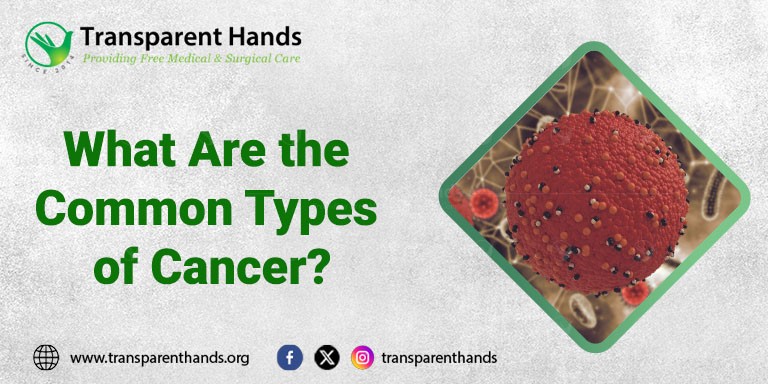What Are the Common Types of Cancer?

Do you know that approximately 40.5 % of men and women are likely to be diagnosed with cancer at some point in their life? Whether it’s a personal diagnosis or that of a loved one, the burden of cancer affects the well-being of the entire family. From exhausting treatments to long recovery periods, the physical effects of cancer are combined with the fear of uncertainty and emotional trauma both for the patients and their loved ones.
However, with so many different types of cancer, understanding the basics can make a significant difference in the early detection and treatment of this deadly disease. This article will explore the most common types of cancer, their symptoms, available treatment options, and ways to support cancer patients.
Common Types of Cancer
Here is a list of some of the common types of cancer:
Breast Cancer
Originating in the cells of the breast, this cancer is primarily detected in women but can also occur in men. A major sign in the detection of this type of cancer is the formation of a lump or mass in the breast area. Symptoms like nipple discharge, skin dimpling, and changes in breast shape also indicate the same.
The causes of this cancer include genetic mutations like BRCA1 and BRCA2, obesity, alcohol consumption, family history, and age. Regular screenings, such as a mammogram, can help in detecting breast cancer at an earlier stage. This can prove to be extremely beneficial for treatment as the detection of breast cancer at an early stage increases the success rate of cure by 99%.
Join Us in fighting cancer across Pakistan
Lung Cancer
The deadliest among all types of cancer, lung cancer accounts for 18.7% of all cancer deaths. It is caused by the uncontrollable growth of cancerous cells in the lung tissues and is mostly a side effect of smoking which is responsible for 85% of such cases. Other contributing factors are secondhand smoke and other environmental pollutants.
Symptoms of lung cancer include constant coughing, chest pain, coughing up blood, and shortness of breath. Performing surgery to remove the tumor from the lungs or employing methods like targeted therapy and high radiation treatment can help patients fight this cancer.
Prostate Cancer
Prostate cancer is mostly found in men above the age of 50 as a result of certain risk factors which include age, family history, specific genetic mutations, and race. Some of the primary symptoms include difficulty in urination, blood in urine and semen, bone pain, and pelvic discomfort. An important method to detect this cancer early is regular PSA tests, which help diagnose prostate issues and receive proper early treatment.
Colorectal Cancer
Colorectal cancer affects the colon or rectum, which are parts of the large intestine. Just like all the other types of cancer, it develops when cells in these areas begin to grow uncontrollably, forming tumors. Several factors can increase the risk for this type of cancer, including age, family history, and certain genetic conditions. Lifestyle choices also play a major role. For instance, diets high in processed meats, lack of physical activity, obesity, smoking, and excessive alcohol consumption can all contribute to its development.
Symptoms of colorectal cancer can vary but often include changes in bowel habits, blood in the stool, abdominal pain, unexplained weight loss, and fatigue. Since early detection is key to successful treatment, regular screenings like colonoscopies are highly recommended.
Skin Cancer
Skin cancer develops when skin cells become damaged and start growing abnormally, often due to prolonged exposure to UV radiation from the sun or tanning beds. It’s a common type of cancer and can affect people of all skin tones.
There are three main types of skin cancer. First is Basal cell carcinoma which often looks like a shiny bump. Next, we have Squamous cell carcinoma, which usually appears as a red, scaly patch. Lastly, Melanoma is the most dangerous and can be identified by moles that change in size, shape, or color.
Regular skin checks-ups are crucial for early detection, and improving treatment success. Treatment options include surgery, radiation therapy, and topical medications.
Save a cancer patient’s Life
Bladder Cancer
The bladder is the organ in the lower abdomen that stores urine. It develops cancer when abnormal cells multiply in the bladder lining, causing symptoms like blood in urine, frequent urination, pain while urinating, and pain in the lower back.
Several factors increase the risk of getting bladder cancer, including smoking, exposure to harmful chemicals, chronic bladder infections, and a family history of bladder cancer. Since early detection makes treatment more effective, regular checkups are important along with treatment options like chemotherapy, immunotherapy, surgery, and more.
Blood cancer
Blood cancer, or hematologic cancer, affects how blood cells are made and function. It usually begins in the bone marrow, where blood is produced. There are three main types: leukemia, lymphoma, and myeloma.
Symptoms can include fatigue, frequent infections, and unexplained weight loss. Blood cancers are to be taken very seriously as according to the Leukemia & Lymphoma Society, someone in the United States dies from a blood cancer about every 9 minutes.
How Transparent Hands’ Fights Cancer in Pakistan
Transparent Hands is a leading non-profit organization in Pakistan dedicated to providing free healthcare services, including cancer treatment, to underprivileged patients. We are trying to make a difference in the fight against cancer in Pakistan by providing free chemotherapy, surgeries, and radiotherapy sessions to patients who can’t afford the high cost of treatment. For instance, recently we helped Shamim Bibi, a mother of three children, overcome breast cancer through chemotherapy. Our efforts have changed and saved many lives.
With each type of cancer having its own set of symptoms, causes, and treatment options, it is important to keep an eye open for the signs of cancer and undergo regular check-ups. Consider supporting organizations like Transparent Hands to support cancer patients belonging to low-income communities











Leave Your Comments